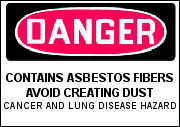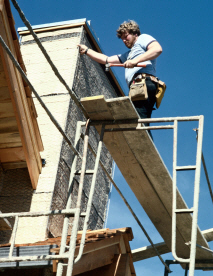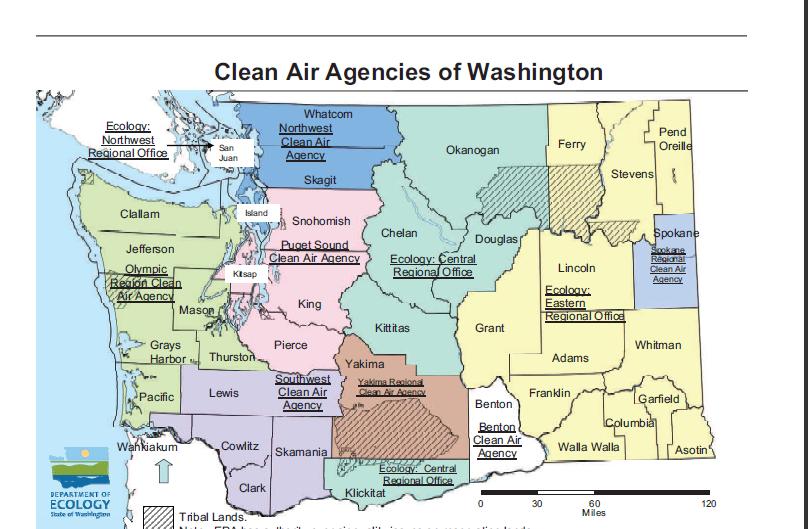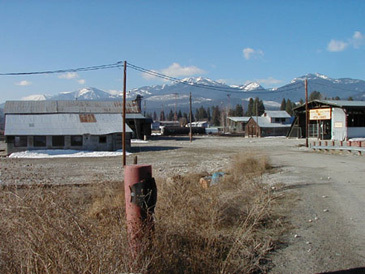 Asbestos Information Asbestos Information
Asbestos is a tiny fiber that was used in the past primarily as insulation. It was also added to some building materials to provide added strength and flame resistance. The problem with asbestos is that it has been shown to cause lung cancer and mesothelioma in individuals that were exposed to large amounts of free-floating asbestos fibers in the air. These conditions typically did not become apparent until around 30 years after the exposure. Because of the health hazards of asbestos fibers, its use in insulation and paint was banned in the 1970’s.
What you need to know about asbestos
Homes built prior to the 1970’s could contain asbestos in insulation, plumbing, paint, wall joint compound, and other building materials. However, as long as the materials are in good condition, they pose no danger. Asbestos is only a threat if the fibers are released into the air and can be inhaled.
Renovations or demolitions of materials containing asbestos can release the fibers into the air. Therefore, the National Emissions Standards for Hazardous Air Pollutants (NESHAP) requires the owner of any property containing asbestos building materials to get an asbestos inspection prior to any demolitions or renovations of that property.
 How can asbestos be removed? How can asbestos be removed?
If your home contains asbestos, you have two options: removal of the material or sealing the material to prevent it from releasing fibers. Either option requires the help of a trained professional.
How do I know if my home contains asbestos?
If you suspect your home or a home you are considering buying may contain asbestos, it’s vital you get a thorough inspection by a qualified professional. Asbestos can only be detected by a special microscope. Our inspectors are trained in asbestos detection and will take samples from your home for further analysis. Please contact our office for further information.
Types of Asbestos The term "asbestos" refers to six fibrous minerals that have been commercially exploited and occur naturally in the environment. The U.S. Bureau of Mines has named more than 100 mineral fibers as "asbestos-like" fibers, yet only six are recognized regulated by the U.S. government. This is largely due to influential lobbying by the asbestos and stone industries, which powerfully shaped how the public perceives asbestiform minerals. The six asbestiform minerals recognized by the government include, tremolite asbestos, actinolite asbestos, anthophyllite asbestos, chrysotile asbestos, amosite asbestos, and crocidolite asbestos. Each of these minerals is categorized into two groups, serpentine and amphibole. Chrysotile asbestos is the only member of the serpentine group and the others belong to the amphibole group. The difference between these two groups is characterized by the physical components of the asbestos fibers. The serpentine group is made up of minerals that have a layered form and curly fibers and the latter group contains minerals that have straight fibers with a chain-like structure. In order to fully understand the importance and function of these minerals, it is necessary to examine each mineral in more detail.
Chrysotile asbestos is better known as white asbestos and is made up of fine, silky, flexible white fibers. Chrysotile consists of minerals crystallized in a serpentine pattern, which means its crystals are formed in sheets. This is the most common type of asbestos comprising approximately 95 percent of all asbestos commercially used in the United States. Due to the widespread use of this fiber, chrysotile accounts for the majority of asbestos-related health problems throughout the world.
Tremolite is a relatively common mineral found in most metamorphic rocks. Its color ranges from a creamy white to dark green. Tremolite asbestos has been used for industrial purposes (though not as much as chrysotile) and has been identified as an ingredient in some household products, primarily talcum powder (which is also a known carcinogen). This form of asbestos is the major asbestiform contaminant of the infamous vermiculite mine in Libby, Montana.
Actinolite asbestos is a relatively common mineral existing in metamorphic rocks. This type of asbestos is usually green, white, or gray and it is closely related to the aforementioned tremolite mineral (actinolite contains a greater presence of iron over magnesium than tremolite). Actinolite does not have a strong history of commercial or industrial use, but it may be a contaminant in asbestos products. There are non-fibrous variants of actinolite that do not pose the same health threats associated with exposure to commercially exploited forms of asbestos.
Anthophyllite asbestos is commonly identified by its brittle white fibers that are made of crystals and have a chain-like appearance. This type of asbestos is formed by the breakdown of talc in ultramafic rock, and as such, anthophyllite is a common contaminant of talc. Although anthophyllite asbestos is not often used for industrial purposes, the fibers can occasionally be found among natural minerals that expand with the application of heat, such as vermiculite (which is commonly added to gardening soil).
Amosite asbestos is identified by its straight, brittle fibers that are light gray to brown in color. Amosite is also referred to as brown asbestos and its name is derived from the asbestos mines located in South Africa. In years past, amosite was often used as an insulating material and at one time it was the second-most commonly used type of asbestos. Throughout recent decades, commercial production of amosite has decreased and its use as an insulating material has been banned in many countries.
Crocidolite asbestos, better known as blue asbestos, is markedly identified by its straight blue fibers. This form is believed to be the most lethal form of asbestos. Crocidolite asbestos occurs naturally in locations such as Australia, South Africa, Bolivia, the former Soviet Union, and Canada.
Who Can Remove Asbestos
Only with some rare exceptions, you must hire a state certified asbestos abatement contractor to perform the removal for you. These highly trained and certified professionals have the equipment and know-how to do the job according to the safety and environmental standards by the regulations, and each supervisor and worker performing the job have the experience and is individually trained and certifies as well. One thing to bear in mind: unless you get the name of a contractor from the state authority, you can't take it for granted the contractor is really certified just because the internet search or the telephone listing says so. BAI Services Inc. has worked with numerous asbestos abatement contractors and would be willing to help our clients to locate an asbestos contractor that is recommendable, will meet your price, location and job scope criteria. The exceptional case is when you are the owner of and currently living in a single family, non-multiple unit house. You can perform the removal yourself if you chose to, but remember it won’t be easy and it may not be the safest thing for you and your family. It is important to note that even under the best of circumstances, home owner performed asbestos projects can be physically demanding and potentially dangerous. First of all, you will have to breath through a respirator and it’s more difficult than normal breathing and places an additional stress on the heart and lungs. A physician should be consulted before anyone performs strenuous work while wearing a respirator. In addition, protective clothing can be hot and uncomfortable, work spaces become very humid due to the water used in wetting the asbestos, eye protection often results in reduced visibility, and caution must be taken with wiring and electrical power because water is used to wet the asbestos. Furthermore, the work may cause damages. The removal procedures may result in damage to walls and ceilings. Duct tape can discolor wood paneling, tear wallpaper and remove paint and texture. Water may stain walls and damage floors. Using metal scrapers on wetted plasterboard ceilings may result in tearing of the plasterboard paper. You will have to wear special protective gears to protect yourself, and an appropriate respirator, disposable coveralls, disposable gloves, and rubber boots should be prepared. Since wetting is critical during and after removal in order for asbestos materials to be thoroughly saturated with water keeping asbestos fibers out of the air, the wet environment may cause additional difficult and damage. You will have to know how to set up a containment area and remove it after the job is done, and you will also know how to decontaminate the area and your equipment to make sure you didn’t pollute your house. Finally, you will have to know the sites and procedure to disposal the asbestos waste. Asbestos Regulations
EPA works to develop and enforce regulations that implement environmental including asbestos laws enacted by Congress. EPA is responsible for researching and setting national standards for a variety of environmental programs including the regulation of asbestos, and delegates to states and tribes the responsibility for issuing permits and for monitoring and enforcing compliance. Where national standards are not met, EPA can issue sanctions and take other steps to assist the states and tribes in reaching the desired levels of environmental quality. EPA has 10 regional offices around the nation to facilitate its enforcing environmental laws and work with the local state agencies. The clickable map below outlines the boundaries between each region. When you click your appropriate region, you’ll be taking the region’s website directly, where you can find contact information and other useful information.

Other Federal Agencies Have Regulations and Play a Role in Asbestos
Occupational Safety and Health Administration (OSHA)
An estimated 1.3 million employees in construction and general industry face significant asbestos exposure on the job. Heaviest exposures occur in the construction industry, particularly during the removal of asbestos during renovation or demolition. Employees are also likely to be exposed during the manufacture of asbestos products (such as textiles, friction products, insulation, and other building materials) and during automotive brake and clutch repair work. Asbestos is well recognized as a health hazard and is highly regulated.
OSHA and EPA asbestos rules are intertwined. Under U.S. Department of Labor, OSHA's Role is to assure the safety and health of America's workers by setting and enforcing standards; providing training, outreach, and education; establishing partnerships; and encouraging continual improvement in workplace safety and health.
Consumer Product Safety Commission (CPSC)
The Consumer Product Safety Commission (CPSC) is an independent federal regulatory agency that was created in 1972 by Congress in the Consumer Product Safety Act. In that law, Congress directed the Commission to protect the public against unreasonable risks of injuries and deaths associated with consumer products including asbestos-containing products.
Agency for Toxic Substances and Disease Registry (ATSDR)
The mission of the Agency for Toxic Substances and Disease Registry (ATSDR), as an agency of the US Department of Health and Human Services, is to prevent exposure and adverse human health effects and diminished quality of life associated with exposure to hazardous substances from waste sites, unplanned releases, and other sources of pollution present in the environment.
National Institute for Occupational Safety and Health (NIOSH)
The National Institute for Occupational Safety and Health (NIOSH) is the Federal agency responsible for conducting research and making recommendations for the prevention of work-related disease and injury. The Institute is part of the Centers for Disease Control and Prevention (CDC). NIOSH maintains a listing of Asbestos publications. NIOSH's publications may be of interest to the general public but are targeted specifically to occupational safety and health issues.
National Institute of Standards and Technology (NIST)
Founded in 1901, NIST is a non-regulatory federal agency within the US Commerce Department's Technology Administration. NIST's mission is to develop and promote measurements, standards, and technology to enhance productivity, facilitate trade, and improve the quality of life. NIST maintains a listing of accredited asbestos laboratories under the National Voluntary Laboratory Accreditation Program (NVLAP).
NIST maintains a for PLM asbestos testing among other listings.
Mine Safety and Health Administration (MSHA)
MSHA is currently developing a website covering asbestos issues as they relate to mining activities. The mission of the Mine Safety and Health Administration (MSHA) is to administer the provisions of the Federal Mine Safety and Health Act of 1977 (Mine Act) and to enforce compliance with mandatory safety and health standards as a means to eliminate fatal accidents; to reduce the frequency and severity of nonfatal accidents; to minimize health hazards; and to promote improved safety and health conditions in the Nation's mines. MSHA carries out the mandates of the Mine Act at all mining and mineral processing operations in the United States, regardless of size, number of employees, commodity mined, or method of extraction.
Regulatory Agencies at the State Level (State of Washington as an example)
WISHA, administered by the state's Department of Labor and Industries, is Washington State's occupational safety and health program, designed to assure, so far as reasonable possible, safe and healthful working conditions for all workers in the state. Established in 1973 when the Legislature passed the Washington Industrial Safety and Health Act, WISHA is administered by the state's Department of Labor and Industries. Federal OSHA approves, monitors and partially funds "state plan" programs. The OSH Act requires state plans to be at least as effective as OSHA. In most counties, asbestos is regulated by local air pollution control agencies, or clean air agencies. However, the Washington State Department of Ecology provides these services for other counties that are beyond the jurisdiction of any local clean air agencies. The map below shows the jurisdictions boundaries of the local clean air agencies, the Department of Ecology and the Tribes.

Listed below are the contact information for each clean air agencies and Department of Ecology regional offices.
Olympic Region Clean Air Agency (Clallam, Grays Harbor, Jefferson, Mason, Pacific, Thurston Counties)
2940 B Limited Lane NW
Olympia WA 98502
Richard Stedman, Executive Director
Telephone: (360) 586-1044 or 1-800-422-5623
Fax: (360) 491-6308 Dept. of Ecology Northwest Regional Office (San Juan County)
3190-160th Avenue SE
Bellevue WA 98008-5452
Telephone: (425) 649-7000
Fax: (425) 649-7098, TTY: 1-800-833-6388
Northwest Air Pollution Authority (Island, Skagit, Whatcom Counties)
1600 South Second Street
Mount Vernon, WA 98273-5202
Mark Asmundson, Director
Telephone: (360) 428-1617
Telephone: 1-800-622-4627 (Island Whatcom)
Fax: (360) 428-1620;
Puget Sound Clean Air Agency (King, Kitsap, Pierce, Snohomish Counties)
1904 Third Avenue, Suite 105
Seattle, WA 98101-3317
Telephone: (206) 343-8800 or 1-800-552-3565
Southwest Clean Air Agency (Clark, Cowlitz, Lewis, Skamania, Wahkiakum Counties)
11815 NE 99th Street, Suite 1294
Vancouver WA 98682
Robert D. Elliott, Executive Director
Telephone: (360) 574-3058 or 1-800-633-0709
Fax: (360) 576-0925;
Dept. of Ecology Central Regional Office (Chelan, Douglas, Kittitas, Klickitat, Okanogan Counties)
15 West Yakima Avenue, Suite 200
Yakima, WA 98902-3401
Telephone: (509) 575-2490
Fax: (509) 575-2809, TTY: 1-800-833-6388
Yakima Regional Clean Air Authority
6 South 2nd Street, Room 1016
Yakima, WA 98901
Gary Pruitt, Director
Telephone: (509) 574-1410 or 1-800-540-6950
Fax: (509) 574-1411;
Dept. of Ecology Eastern Regional Office (Adams, Asotin, Columbia, Ferry, Franklin, Garfield, Grant, Lincoln, Pend Oreille, Stevens, Walla Walla, Whitman Counties)
4601 N. Monroe Street,
Spokane, WA 99205-1295
Telephone: (509) 329-3502
Fax: (509) 329-3529, TTY: 1-800-833-6388
Spokane County Air Pollution Control Authority
1101 West College Ave, Suite 403
Spokane, WA 99201
Bill Dameworth, Director
Telephone: (509) 477-4727
Fax: (509) 477-6828 Benton Clean Air Authority
114 Columbia Point Dr., Suite C
Richland, WA 99352-4387
Dave Lauer, Director
Telephone: (509) 943-3396
Fax: (509) 943-0505 or 943-2232
Telephone: (509) 945-4489 (Burn Ban Recording)
Asbestos in the United States
Asbestos has been identified in 20 States (see figure) and mined in 17 States over the past 100 years. It is found in many common rocks. Serpentinite, the most widely occurring host rock for chrysotile, is present throughout the Appalachians, Cascades, Coast Ranges of California and Oregon, and other mountain belts.
In general, chrysotile and amphibole asbestos varieties occur in areas where the original rock, under elevated temperatures and pressures, has been changed by heated fluids (a process referred to as metamorphism). This type of altered rock occurs predominantly along the eastern seaboard from Alabama to Vermont, along the western seaboard from California to Washington, and in the upper Midwest in Minnesota and Michigan. Small occurrences of asbestos are in other areas, such as Arizona, Idaho, and Montana. Although asbestos can be present in most of the metamorphic rocks described above, the bulk of the rock mass does not contain asbestos. In fact, most commercial asbestos deposits contain less than 6 percent asbestos by volume. Only a few deposits contain 50 percent or more asbestos (such as chrysotile deposits near Coalinga, Calif.).
Type of Occurrence
Most common type of chrysotile deposit grow with the fibers at right angles to the walls of cracks (cross-vein) in massive serpentine formations. In some occurrences, the relative motions (slipping) of blocks in the host rock, during or after fiber growth, lead to veins in which the fibers are inclined or parallel to the vein axes (slip fibers). In still other local conditions, dispersed aggregates of fibers are found with no preferential orientation but with high fiber content, up to 50% of the surrounding rocks. These are called mass fiber deposits. The Amphiboles occur as small and isolated pockets, irregular veins in the more metamorphism altered rock formations.
Relative Abundance of Asbestos
Chrysotile is more abundant than amphiboles. It occurs in two thirds of the Earths crust. As a matter of fact, figures show that between 90% and 95% of all asbestos found in buildings and other commercial products that contain asbestos is of the Chrysotile variety.
The amphiboles are found in limited areas, mainly in parts of Australia, Africa, China and Parts of former Soviet Union.
Asbestos in Building Materials
Acoustical Plaster
Adhesives
Asphalt Floor Tile
Base Flashing
Blown-in Insulation
Boiler Insulation
Breaching Insulation
Caulking/Putties
Ceiling Tiles and Lay-in Panels
Cement Pipes
Cement Siding
Cement Wallboard
Construction Mastics (floor tile, carpet, ceiling tile, etc.)
Cooling Towers
Decorative Plaster
Ductwork Flexible Fabric Connections
Electrical Cloth
Electrical Panel Partitions
Elevator Brake Shoes
Elevator Equipment Panels
Fire Blankets
Fire Curtains
Fire Doors
Fireproofing Materials
Flooring Backing
Heating and Electrical Ducts
High Temperature Gaskets
HVAC Duct Insulation
Joint Compounds
Laboratory Gloves
Laboratory Hoods/Table Tops
Packing Materials (forwall/floor penetrations)
Pipe Insulation (corrugated air-cell block)
Roofing Felt
Roofing Shingles
Spackling Compounds
Spray-Applied Insulation
Taping Compounds (thermal)
Textured Paints/Coatings
Thermal Paper Products
Vinyl Floor Tile
Vinyl Sheet Flooring
Vinyl Wall Coverings
Wallboard
|
 Asbestos Information
Asbestos Information How can asbestos be removed?
How can asbestos be removed?


